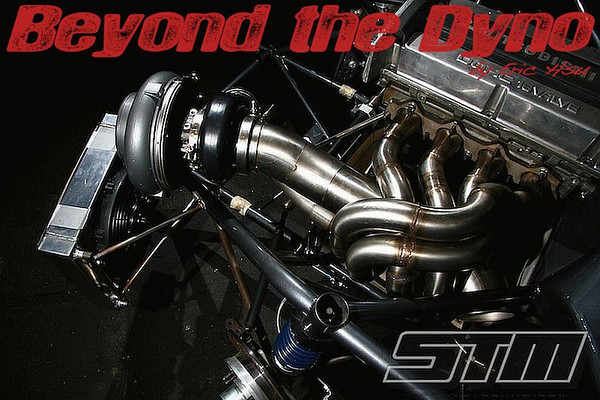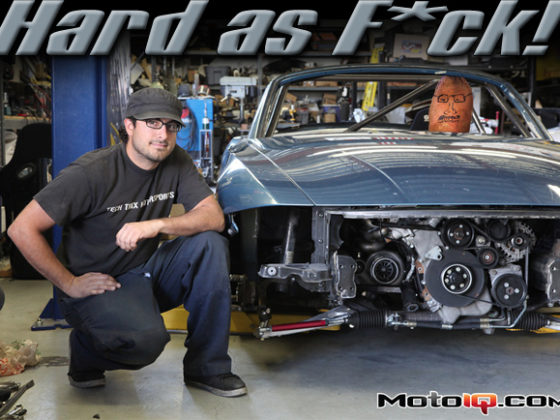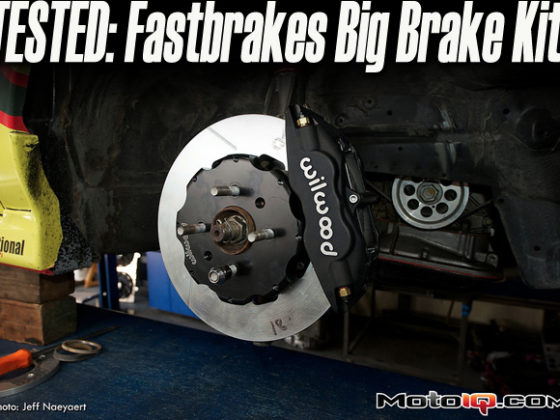,

The engine is an STM designed drag special. It displaces 2.1L with R&R Racing aluminum rods, 11.0:1 JE Pistons, and a billet 92mm stroke crankshaft. The 92mm stroke was chosen to keep piston speeds under control at 10,500-11,000 rpm. While piston speeds are still astronomical, this engine only needs to do it for short durations and benefits from methanol to keep combustion temperatures and piston expansion under control. The beefy aluminum rods actually absorb a good deal of shock from being transmitted to the big end bearing and crankshaft helping to keep the engine in one piece. The flipside is that the rods need to be replaced every 50-60 passes due to material fatigue.

Here’s a close up of the cement filled block and o-ring grooves. The block is filled solid with a cement-like block stiffener, but STM still runs water through the cylinder head to keep it cool. The cement has a very similar expansion rate to the cast iron cylinder block. Filling the block stiffens it and minimizes distortion at 60+ psi of boost. All specs are proprietary to STM (Andre wouldn’t give ’em up!) and are a proven formula that they’ve built many times in the past.

After filling the block, the block is then bored and honed with a torque plate to simulate the distortion of a cylinder head being torqued in place. This allows the cylinders to be as round as possible during operation which decreases irregular bore wear, increases compression, and reduces blow by. Here Ray @ STM is putting some playdoh in the valve reliefs to double check valve to piston clearance. The STM spec billet cams have tons of duration and lift since the engine needs to be making power at 11,000rpm. There’s no skipping details like V to P clearance in a all out engine build like this. Another tricky part of using aluminum connecting rods is that they actually grow in length when they are hot effectively reducing V to P during the pass.

Here Ray files the ring’s end gap with an electric ring filer. These are handy because you can measure the amount of material being ground away while keeping the ground faces perfectly parallel. Since the block is being run without water, both piston to cylinder wall clearance and piston ring end gaps are run significantly looser that in an engine with coolant in it.

Here Ray is fabricating the brake lines for the 4 pot Mark Williams brake callipers. In this photo the size and strength of the diff housing is obvious. The housing is an ultra heavy duty fabricated 9” unit from Jerry Bickel Race Cars and was finished by Top Gear Autotech. The rear end is fitted with a Mark Williams alloy spool which is equipped with 9” Pro Gears designed specifically for drag racing. The Pro Gears have a softer surface hardening than a regular heavy duty ring and pinions. The softer gears are less likely to crack, but they also wear quicker over time. Lucky this diff is only ever going to travel a 1/4 nile at a time! Other drag-only modifications in the rear end include a heavy duty support bearing for the end of the pinion. This stops the pinion from flexing away from the ring gear which can cause failures in extreme high power applications.


STM wasn’t happy with the original one piece nose so Zac from Carboglass took the job of bringing it up to spec. It was stretched just a hair to improve aerodynamics. All of the holes except for the LH head light opening are closed up in the final version of the nose. Here Zac and Bam are confirming fitment before the nose is finished off.

On the inside Bam made a mount for the Motec SDL dash unit. The SDL is an advanced display and datalogger which is invaluable for analysing run data in a race car. While Mike won’t get the chance to look at it during a run, it communicates to the Motec Shift light Module (SLM) to tell Mike when to change gears and will display a warning light if there are any errors. The SLM and warning light are enough to get Mike’s attention without him needing to look specifically at the dash during the run. If a warning is triggered, Mike can glance at the dash which will display the actual warning message. This works very much like a check engine light in a street car. The engine is controlled by a Motec M800 ECU, M888 Expansion unit, and a M&W Pro Drag CDI for igntion amplification. Andre @ STM handles all of the tuning and data analysis.

A wheel speed sensor is fitted to the front right wheel so that vehicle speed can be datalogged. If the rear wheel speed is used, the data would be inaccurate when the rear wheel spins. A 34” slick will also grow in diameter by over 2” at 180+ mph, so the front wheel speed would be the most accurate in this situation.



